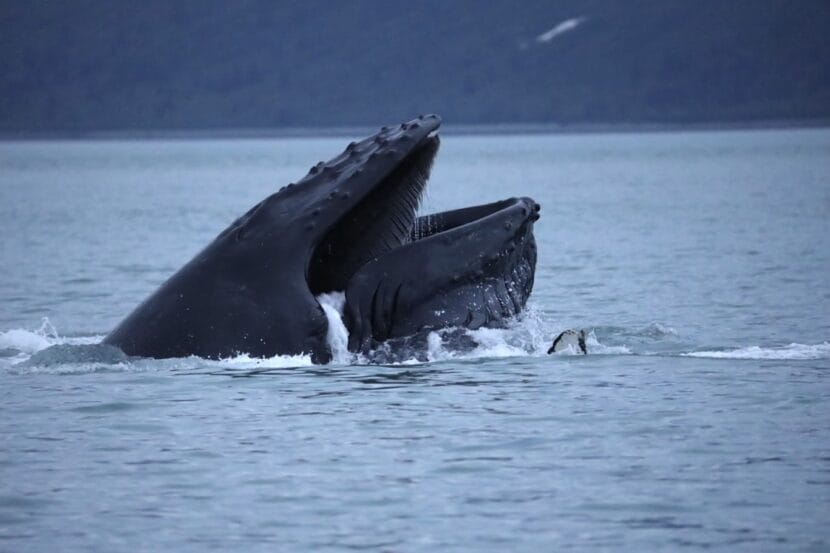Wildlife biologist Janet Neilson keeps a close eye on Alaska humpbacks. For the National Park Service whale monitoring program, she keeps a count of the whales that migrate up from Hawaii to feed in Glacier Bay and Icy Strait every summer.
During the summers between 2014 and 2018, she and researcher Chris Gabriele, who has led the park’s monitoring program for three decades, noticed something was off.
“Young whales, calves went missing. We had whales in the prime years of their lives go missing. And we certainly had some older whales go missing as well,” Neilson said. “But it really seemed like it hit all the whales.”
Neilson is one of 75 co-authors on a new study, which finds that almost 7,000 North Pacific humpbacks went missing between 2012 and 2021 — a 20% drop-off from the peak population of more than 33,000. Researchers believe they starved to death during the record-setting marine heatwave known as “the blob.”
Naturalist Ted Cheeseman is the one who brought all the whale researchers together. He’s the founder of Happy Whale, a photo database that uses artificial intelligence to quickly identify individual whales by the unique black-and-white patterns on the underside of their tail fins, or flukes. With Happy Whale, Cheeseman set out to do a simple population count.
“But when we first saw these numbers, it turned a population study into a climate study,” Cheeseman said.
That’s because the database revealed a sharp decline in humpbacks that coincided with “the blob,” which spiked ocean temperatures from Alaska to California between 2014 and 2016, killing fish, seabirds and more than 30% of Alaska’s humpbacks.
Climate change may complicate the species’ conservation success story. Back in the 1990s, Cheeseman worked as a tour guide in Antarctica. And he said humpbacks were hard to come by back then.
“We didn’t see many whales at all,” Cheeseman said. “We did, however, visit some of the largest whaling stations that were ever built — you know, they’re factories. Absolutely factories to turn living whales into product.”
Commercial whaling pushed humpbacks to the brink of extinction, but their populations in the North Pacific have boomed since it ended. Humpbacks were taken off the endangered species list in 2016. But around that same time, researcher Heidi Pearson was seeing the whales around Juneau get skinnier and skinnier.
Pearson, who researches at the University of Alaska Southeast, says these whales are usually more adaptable than other marine species. They can travel long distances to find food. And their diet is flexible.
“So the fact that they still declined due to what we think is lack of prey means that it must have been really bad,” she said.
She says she still believes in the resilience of humpbacks. But the study’s results make it clear that the species is feeling the pressure of warming driven by the burning of fossil fuels.
“I really learned a lot about the fragility, actually, of the ocean system to this warming,” Pearson said. “Animals and systems are resilient, but clearly during the heatwave they reached this tipping point.”
For Neilson, in Glacier Bay, the decline emphasizes the need to protect humpbacks even when their populations seem healthy. Though they’re recovering in Glacier Bay, she says, they’re still not back to their pre-heatwave levels. And they’re also frequently threatened by ship strikes and entanglements in fishing gear near the coast.
“It’s important to realize that the whales that we do see out on the water these days are survivors of a major ecological disruption,” Neilson said. “Those survivors deserve protection because more heat waves are coming.”
As those heatwaves come, real-time population monitoring for humpbacks may be more important than ever bef0re. The whales, which are large, coastal animals that are easy to track, can be indicators of overall ecosystem health in a rapidly changing ocean.
Technology like Happy Whale can help researchers better track whales as they migrate all across the North Pacific. The new study pulled more than 200,000 fluke images from the database, which were collected from researchers and more than 4,000 citizen scientists.
“The scale of problems that our world is facing today within the environmental realm — climate change being the biggest one — they’re only going to be solved by collaboration,” Pearson said. “No one can do it alone, in their one study site. “






